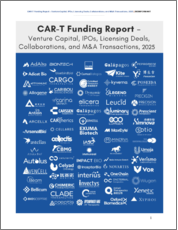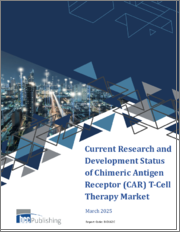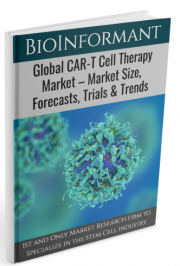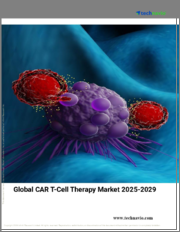
|
시장보고서
상품코드
1279870
세계의 CAR T세포치료 시장 규모 조사 및 예측 : 적응증별, 약물 유형별, 최종사용자 및 지역별 분석(2023-2030년)Global CAR T-Cell therapy Market Size study & Forecast, by Indication, By Drug Type, By End user, and Regional Analysis, 2023-2030 |
||||||
세계 CAR T세포치료제 시장은 2022년 약 19억 3,000만 달러로 평가되며, 예측 기간인 2023-2030년에는 13.5% 이상의 건전한 성장률로 성장할 것으로 예상됩니다.
키메라 항원 수용체(CAR) T세포 치료는 새로운 형태의 암 치료법으로, 의료 전문가가 실험실에서 T세포를 변형시킨 후 암 환자의 몸에 주입하여 암세포를 감지하고 제거할 수 있도록 하는 새로운 형태의 암 치료법입니다. CAR T세포치료는 악성 세포에 대한 면역 반응을 촉진하며, CAR T세포치료 시장은 주로 암 치료에 적합한 치료제에 대한 수요 증가, 일부 국가에서 CAR T세포치료제에 대한 유리한 상환 정책, CAR T세포치료제에 대한 소비자 인식 증가에 의해 주도되고 있습니다. 주도하고 있습니다. 또한 최근 CAR-T 세포치료제의 상업화 및 임상시험 활동이 급증하면서 시장 확대에 더욱 영향을 미치고 있습니다.
또한 백혈병, 림프종 등 암 발생률 증가는 CAR T세포치료수요를 직접적으로 증가시키고 있습니다. 세계보건기구(WHO)에 따르면 2020년 백혈병 암 환자 수는 475,000명으로 추정되며, 2040년에는 692,000명에 달할 것으로 예측됩니다. 따라서 암 유병률 증가는 다양한 진단 및 치료 옵션에 대한 수요를 촉진하여 CAR T세포치료 시장의 성장을 가속화하고 있습니다. 또한 연구개발에 대한 투자 증가와 기술 발전은 예측 기간 중 다양한 유리한 기회를 가져올 것입니다. 그러나 숙련된 전문가의 부족과 CAR T세포치료의 높은 개발 비용은 2023-2030년의 예측 기간 중 시장 성장에 도전이 되고 있습니다.
세계의 CAR T세포치료 시장 조사에서 고려된 주요 지역은 아시아태평양, 북미, 유럽, 라틴아메리카, 중동 및 아프리카입니다. 북미는 규제 당국의 승인 증가, 신흥 시장에 대한 투자 증가, 기술 개발의 발전으로 인해 2022년 시장을 장악했습니다. 반면 아시아태평양은 예측 기간 중 가장 높은 CAGR로 성장할 것으로 예상됩니다. 암 유병률 증가, 정부 기관의 새로운 치료제에 대한 연구 자금 증가, 새로운 치료제의 인지도 향상 및 승인 증가는 이 지역 전체 시장 수요를 크게 촉진하고 있습니다.
이 연구의 목적은 최근 수년간 다양한 부문과 국가 시장 규모를 정의하고 향후 수년간의 가치를 예측하는 것입니다. 이 보고서는 조사 대상 국가의 산업의 질적, 양적 측면을 모두 포함하도록 설계되었습니다.
또한 시장의 미래 성장을 규정하는 촉진요인과 과제와 같은 중요한 측면에 대한 자세한 정보도 제공합니다. 또한 주요 기업의 경쟁 구도와 제품 제공에 대한 상세한 분석과 함께 이해관계자가 투자할 수 있는 미시적 시장에서의 잠재적 기회도 포함됩니다.
목차
제1장 주요 요약
- 시장 스냅숏
- 세계 시장·부문별 시장 추산·예측, 2020-2030년
- CAR T세포치료 시장 : 지역별, 2020-2030년
- CAR T세포치료 시장 : 적응증별, 2020-2030년
- CAR T세포치료 시장, 약제 유형별, 2020-2030년
- CAR T세포치료 시장 : 최종사용자별, 2020-2030년
- 주요 동향
- 조사 방법
- 조사의 전제조건
제2장 세계의 CAR T세포치료 시장 정의와 범위
- 조사 목적
- 시장 정의와 범위
- 산업의 진화
- 본 조사의 대상 범위
- 본 조사의 대상년
- 통화 환산율
제3장 세계의 CAR T세포치료 시장 역학
- CAR T세포치료 시장의 영향 분석(2020-2030년)
- 시장 촉진요인
- 백혈병이나 림프종 등 암의 발생률 증가
- CAR T세포치료 치료제에 대한 유리한 상환 정책
- 시장이 해결해야 할 과제
- 숙련 전문가의 부족
- CAR T세포치료의 개발 고비용
- 시장 기회
- 연구개발에 대한 투자 확대
- 기술적 진보의 증가
- 시장 촉진요인
제4장 세계의 CAR T세포치료 시장 산업 분석
- Porter's 5 Force 모델
- 공급 기업의 교섭력
- 구매자의 교섭력
- 신규 진출업체의 위협
- 대체품의 위협
- 경쟁 기업간 경쟁 관계
- Porter's 5 Force 영향 분석
- PEST 분석
- 정치적
- 경제적
- 사회적
- 기술적
- 환경
- 법률
- 주요 투자 기회
- 주요 성공 전략
- COVID-19 영향 분석
- 파괴적 동향
- 업계 전문가의 시점
- 애널리스트의 제안과 결론
제5장 세계의 CAR T세포치료 시장 : 적응증별
- 시장 스냅숏
- 세계의 CAR T세포치료 시장 : 적응증별, 실적, 잠재 능력 분석
- 세계의 CAR T세포치료 시장, 적응증별 추정·예측 2020-2030
- 세계의 CAR T세포치료 시장, 하위 부문별 분석
- 림프종
- 급성 림프구성 백혈병
- 기타
제6장 세계의 CAR T세포치료 시장 : 약제 유형별
- 시장 스냅숏
- 세계의 CAR T세포치료 시장 : 약제 유형별, 실적 - 잠재력 분석
- 세계의 CAR T세포치료 시장, 약제 유형별 추정·예측 2020-2030
- 세계의 CAR T세포치료 시장, 하위 부문별 분석
- Axicabtagene Ciloleucel
- Tisagenlecleucel
- Brexucabtagene Autoleucel
- 기타
제7장 세계의 CAR T세포치료 시장 : 최종사용자별
- 시장 스냅숏
- 세계의 CAR T세포치료 시장 : 최종사용자별, 실적 - 잠재 능력 분석
- CAR 세포치료 세계 시장, 최종사용자별 추정·예측 2020-2030년
- 세계의 CAR T세포치료 시장, 하위 부문별 분석
- 병원
- 암치료 센터
제8장 세계의 CAR T세포치료 시장 : 지역별 분석
- 상위의 주요 국가
- 주요 신흥 국가
- CAR T세포치료 시장, 지역별 시장 스냅숏
- 북미
- 미국
- 적응증별 추정·예측, 2020-2030년
- 약제 유형별 추정·예측, 2020-2030년
- 최종사용자별 추정·예측, 2020-2030년
- 캐나다
- 미국
- 유럽 CAR T세포치료 시장 스냅숏
- 영국
- 독일
- 프랑스
- 스페인
- 이탈리아
- 기타 유럽
- 아시아태평양의 CAR T세포치료 시장 스냅숏
- 중국
- 인도
- 일본
- 호주
- 한국
- 기타 아시아태평양
- 라틴아메리카의 CAR T세포치료 시장 스냅숏
- 브라질
- 멕시코
- 중동 및 아프리카
- 사우디아라비아
- 남아프리카공화국
- 기타 중동 및 아프리카
제9장 경쟁 정보
- 주요 기업의 SWOT 분석
- 기업 1
- 기업 2
- 기업 3
- 주요 시장 전략
- 기업 개요
- Autolus Therapeutics
- 주요 정보
- 개요
- 재무 정보(데이터 입수가 가능한 경우만)
- 제품 개요
- 최근 동향
- Bluebird bio, Inc.
- Bristol-Myers Squibb
- Caribou Biosciences, Inc.
- Cartesian Therapeutics, Inc.
- Celgene Corporation
- Gilead Sciences, Inc.(Kite Pharma Inc.)
- Merck & Co., Inc.
- Novartis AG
- Pfizer, Inc.
- Autolus Therapeutics
제10장 조사 프로세스
- 조사 프로세스
- 데이터 마이닝
- 분석
- 시장 추정
- 밸리데이션
- 출판
- 조사의 특징
- 조사의 전제조건
Global CAR T-Cell therapy Market is valued at approximately USD 1.93 billion in 2022 and is anticipated to grow with a healthy growth rate of more than 13.5% over the forecast period 2023-2030. Chimeric antigen receptor (CAR) T cell therapy is a novel form of cancer therapy in which medical experts modify T cells in a lab before injecting them into cancer patients' bodies to enable them to detect and eliminate cancer cells. The immune system is trained to recognize malignant cells by CAR T-cell therapy. The immune response against malignant cells is boosted by CAR T-cell treatment. The market for CAR T-cell therapy is primarily driven by an increase in the demand for suitable therapeutics for the treatment of cancer, favorable reimbursement policies for CAR T-cell therapy medications in some countries, and an increase in consumer awareness of CAR T-cell therapy medications. Additionally, the recent commercialization of CAR-T cell therapy and the surging clinical trial activities are further influencing the market expansion.
In addition, an increase in the incidence of cancer such as leukemia and lymphoma are directly augmenting the demand for CAR T-Cell therapy. According to World Health Organization (WHO), in 2020, the number of leukemia cancer cases is estimated to account for 475 thousand, which is projected to reach 692 thousand patients by the year 2040. Accordingly, the growing prevalence of cancer is fueling the demand for a wide range of diagnosis and treatment alternatives, which, in turn, accelerates the growth of the CAR T-Cell therapy Market. Moreover, the growing investment in research and development, as well as increasing advancements in technology present various lucrative opportunities over the forecasting years. However, the unavailability of skilled professionals and the high cost of developing CAR T-cell therapy are challenging the market growth throughout the forecast period of 2023-2030.
The key regions considered for the Global CAR T-Cell therapy Market study include Asia Pacific, North America, Europe, Latin America, and Middle East & Africa. North America dominated the market in 2022 owing to the increasing regulatory approvals, growing investment in advancing healthcare facilities, and rising technological developments. Whereas, Asia Pacific is expected to grow at the highest CAGR over the forecasting years. The rising prevalence of cancer, increasing research funding for novel therapeutics by government bodies, and growing awareness and increase in approval of novel medications are significantly propelling the market demand across the region.
Major market players included in this report are:
- Autolus Therapeutics
- Bluebird bio, Inc.
- Bristol-Myers Squibb
- Caribou Biosciences, Inc.
- Cartesian Therapeutics, Inc.
- Celgene Corporation
- Gilead Sciences, Inc. (Kite Pharma Inc.)
- Merck & Co., Inc.
- Novartis AG
- Pfizer, Inc.
Recent Developments in the Market:
- In June 2022, Bristol-Myers Squibb Company announced that the company received the U.S. Food and Drug Administration (FDA) approval for Breyanzi CAR T cell therapy to cure refractory or relapsed large B-cell lymphoma after one prior therapy. The Phase 2 pilot company-sponsored research of a CAR T cell treatment in patients with primary refractory or relapsed LBCL served as the foundation for the approval.
- In February 2022, Johnson & Johnson Services, Inc. declared that the U.S. Food and Drug Administration had approved CARVYKTI (ciltacabtagene autoleucel), a BCMA-Directed CAR-T Immunotherapy for the treatment of Patients with Relapsed or Refractory Multiple Myeloma.
Global CAR T-Cell therapy Market Report Scope:
- Historical Data: - 2020 - 2021
- Base Year for Estimation: - 2022
- Forecast period: - 2023-2030
- Report Coverage: - Revenue forecast, Company Ranking, Competitive Landscape, Growth factors, and Trends
- Segments Covered: - Indication, Drug type, End user, Region
- Regional Scope: - North America; Europe; Asia Pacific; Latin America; Middle East & Africa
- Customization Scope: - Free report customization (equivalent up to 8 analyst's working hours) with purchase. Addition or alteration to country, regional & segment scope*
The objective of the study is to define market sizes of different segments & countries in recent years and to forecast the values to the coming years. The report is designed to incorporate both qualitative and quantitative aspects of the industry within countries involved in the study.
The report also caters detailed information about the crucial aspects such as driving factors & challenges which will define the future growth of the market. Additionally, it also incorporates potential opportunities in micro markets for stakeholders to invest along with the detailed analysis of competitive landscape and product offerings of key players. The detailed segments and sub-segment of the market are explained below.
By Indication:
- Lymphoma
- Acute Lymphocytic Leukemia
- Others
By Drug type:
- Axicabtagene Ciloleucel
- Tisagenlecleucel
- Brexucabtagene Autoleucel
- Others
By End-user:
- Hospitals
- Cancer Treatment Centers
By Region:
- North America
- U.S.
- Canada
- Europe
- UK
- Germany
- France
- Spain
- Italy
- ROE
- Asia Pacific
- China
- India
- Japan
- Australia
- South Korea
- RoAPAC
- Latin America
- Brazil
- Mexico
- Middle East & Africa
- Saudi Arabia
- South Africa
- Rest of Middle East & Africa
Table of Contents
Chapter 1. Executive Summary
- 1.1. Market Snapshot
- 1.2. Global & Segmental Market Estimates & Forecasts, 2020-2030 (USD Billion)
- 1.2.1. CAR T-Cell therapy Market, by Region, 2020-2030 (USD Billion)
- 1.2.2. CAR T-Cell therapy Market, by Indication, 2020-2030 (USD Billion)
- 1.2.3. CAR T-Cell therapy Market, by Drug type, 2020-2030 (USD Billion)
- 1.2.4. CAR T-Cell therapy Market, by End user, 2020-2030 (USD Billion)
- 1.3. Key Trends
- 1.4. Estimation Methodology
- 1.5. Research Assumption
Chapter 2. Global CAR T-Cell therapy Market Definition and Scope
- 2.1. Objective of the Study
- 2.2. Market Definition & Scope
- 2.2.1. Industry Evolution
- 2.2.2. Scope of the Study
- 2.3. Years Considered for the Study
- 2.4. Currency Conversion Rates
Chapter 3. Global CAR T-Cell therapy Market Dynamics
- 3.1. CAR T-Cell therapy Market Impact Analysis (2020-2030)
- 3.1.1. Market Drivers
- 3.1.1.1. Increase in the incidence of cancer such as leukemia and lymphoma
- 3.1.1.2. Favorable reimbursement policies for CAR T-cell therapy medications
- 3.1.2. Market Challenges
- 3.1.2.1. Unavailability of skilled professionals
- 3.1.2.2. High cost of developing CAR T-cell therapy
- 3.1.3. Market Opportunities
- 3.1.3.1. Growing investment in research and development
- 3.1.3.2. Increasing advancements in technology
- 3.1.1. Market Drivers
Chapter 4. Global CAR T-Cell therapy Market Industry Analysis
- 4.1. Porter's 5 Force Model
- 4.1.1. Bargaining Power of Suppliers
- 4.1.2. Bargaining Power of Buyers
- 4.1.3. Threat of New Entrants
- 4.1.4. Threat of Substitutes
- 4.1.5. Competitive Rivalry
- 4.2. Porter's 5 Force Impact Analysis
- 4.3. PEST Analysis
- 4.3.1. Political
- 4.3.2. Economical
- 4.3.3. Social
- 4.3.4. Technological
- 4.3.5. Environmental
- 4.3.6. Legal
- 4.4. Top investment opportunity
- 4.5. Top winning strategies
- 4.6. COVID-19 Impact Analysis
- 4.7. Disruptive Trends
- 4.8. Industry Expert Perspective
- 4.9. Analyst Recommendation & Conclusion
Chapter 5. Global CAR T-Cell therapy Market, by Indication
- 5.1. Market Snapshot
- 5.2. Global CAR T-Cell therapy Market by Indication, Performance - Potential Analysis
- 5.3. Global CAR T-Cell therapy Market Estimates & Forecasts by Indication 2020-2030 (USD Billion)
- 5.4. CAR T-Cell therapy Market, Sub Segment Analysis
- 5.4.1. Lymphoma
- 5.4.2. Acute Lymphocytic Leukemia
- 5.4.3. Others
Chapter 6. Global CAR T-Cell therapy Market, by Drug type
- 6.1. Market Snapshot
- 6.2. Global CAR T-Cell therapy Market by Drug type, Performance - Potential Analysis
- 6.3. Global CAR T-Cell therapy Market Estimates & Forecasts by Drug type 2020-2030 (USD Billion)
- 6.4. CAR T-Cell therapy Market, Sub Segment Analysis
- 6.4.1. Axicabtagene Ciloleucel
- 6.4.2. Tisagenlecleucel
- 6.4.3. Brexucabtagene Autoleucel
- 6.4.4. Others
Chapter 7. Global CAR T-Cell therapy Market, by End user
- 7.1. Market Snapshot
- 7.2. Global CAR T-Cell therapy Market by End user, Performance - Potential Analysis
- 7.3. Global CAR T-Cell therapy Market Estimates & Forecasts by End user 2020-2030 (USD Billion)
- 7.4. CAR T-Cell therapy Market, Sub Segment Analysis
- 7.4.1. Hospitals
- 7.4.2. Cancer Treatment Centers
Chapter 8. Global CAR T-Cell therapy Market, Regional Analysis
- 8.1. Top Leading Countries
- 8.2. Top Emerging Countries
- 8.3. CAR T-Cell therapy Market, Regional Market Snapshot
- 8.4. North America CAR T-Cell therapy Market
- 8.4.1. U.S. CAR T-Cell therapy Market
- 8.4.1.1. Indication breakdown estimates & forecasts, 2020-2030
- 8.4.1.2. Drug type breakdown estimates & forecasts, 2020-2030
- 8.4.1.3. End user breakdown estimates & forecasts, 2020-2030
- 8.4.2. Canada CAR T-Cell therapy Market
- 8.4.1. U.S. CAR T-Cell therapy Market
- 8.5. Europe CAR T-Cell therapy Market Snapshot
- 8.5.1. U.K. CAR T-Cell therapy Market
- 8.5.2. Germany CAR T-Cell therapy Market
- 8.5.3. France CAR T-Cell therapy Market
- 8.5.4. Spain CAR T-Cell therapy Market
- 8.5.5. Italy CAR T-Cell therapy Market
- 8.5.6. Rest of Europe CAR T-Cell therapy Market
- 8.6. Asia-Pacific CAR T-Cell therapy Market Snapshot
- 8.6.1. China CAR T-Cell therapy Market
- 8.6.2. India CAR T-Cell therapy Market
- 8.6.3. Japan CAR T-Cell therapy Market
- 8.6.4. Australia CAR T-Cell therapy Market
- 8.6.5. South Korea CAR T-Cell therapy Market
- 8.6.6. Rest of Asia Pacific CAR T-Cell therapy Market
- 8.7. Latin America CAR T-Cell therapy Market Snapshot
- 8.7.1. Brazil CAR T-Cell therapy Market
- 8.7.2. Mexico CAR T-Cell therapy Market
- 8.8. Middle East & Africa CAR T-Cell therapy Market
- 8.8.1. Saudi Arabia CAR T-Cell therapy Market
- 8.8.2. South Africa CAR T-Cell therapy Market
- 8.8.3. Rest of Middle East & Africa CAR T-Cell therapy Market
Chapter 9. Competitive Intelligence
- 9.1. Key Company SWOT Analysis
- 9.1.1. Company 1
- 9.1.2. Company 2
- 9.1.3. Company 3
- 9.2. Top Market Strategies
- 9.3. Company Profiles
- 9.3.1. Autolus Therapeutics
- 9.3.1.1. Key Information
- 9.3.1.2. Overview
- 9.3.1.3. Financial (Subject to Data Availability)
- 9.3.1.4. Product Summary
- 9.3.1.5. Recent Developments
- 9.3.2. Bluebird bio, Inc.
- 9.3.3. Bristol-Myers Squibb
- 9.3.4. Caribou Biosciences, Inc.
- 9.3.5. Cartesian Therapeutics, Inc.
- 9.3.6. Celgene Corporation
- 9.3.7. Gilead Sciences, Inc. (Kite Pharma Inc.)
- 9.3.8. Merck & Co., Inc.
- 9.3.9. Novartis AG
- 9.3.10. Pfizer, Inc.
- 9.3.1. Autolus Therapeutics
Chapter 10. Research Process
- 10.1. Research Process
- 10.1.1. Data Mining
- 10.1.2. Analysis
- 10.1.3. Market Estimation
- 10.1.4. Validation
- 10.1.5. Publishing
- 10.2. Research Attributes
- 10.3. Research Assumption



















